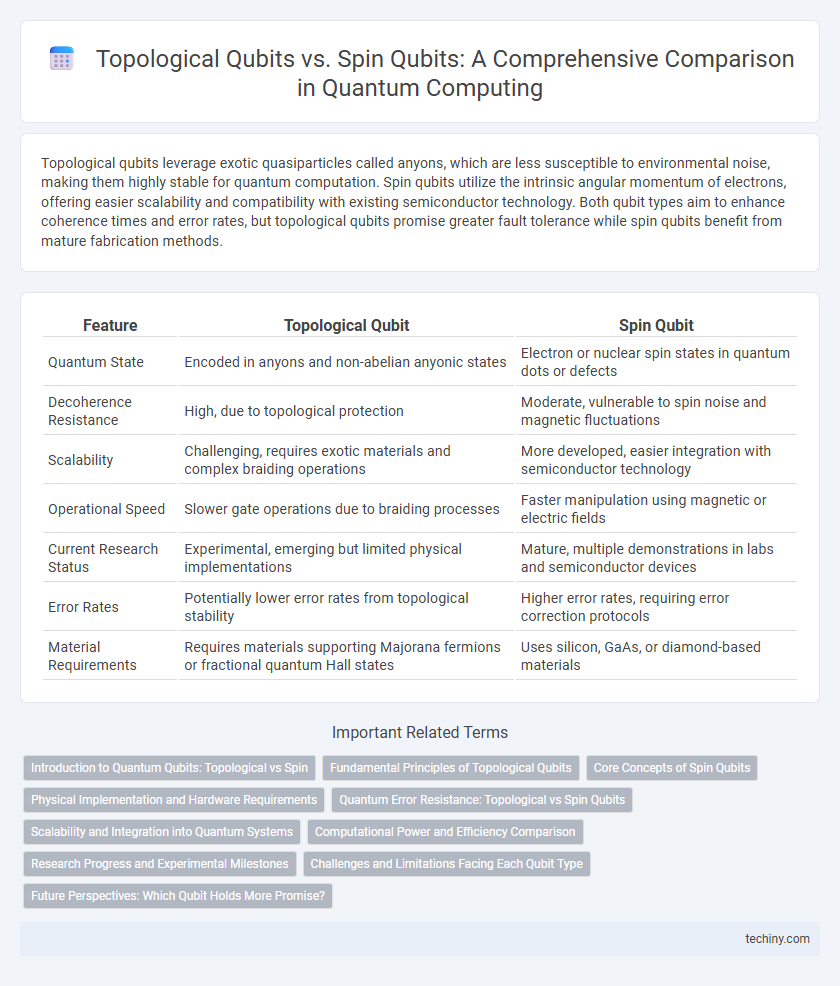Topological qubits leverage exotic quasiparticles called anyons, which are less susceptible to environmental noise, making them highly stable for quantum computation. Spin qubits utilize the intrinsic angular momentum of electrons, offering easier scalability and compatibility with existing semiconductor technology. Both qubit types aim to enhance coherence times and error rates, but topological qubits promise greater fault tolerance while spin qubits benefit from mature fabrication methods.
Table of Comparison
| Feature | Topological Qubit | Spin Qubit |
|---|---|---|
| Quantum State | Encoded in anyons and non-abelian anyonic states | Electron or nuclear spin states in quantum dots or defects |
| Decoherence Resistance | High, due to topological protection | Moderate, vulnerable to spin noise and magnetic fluctuations |
| Scalability | Challenging, requires exotic materials and complex braiding operations | More developed, easier integration with semiconductor technology |
| Operational Speed | Slower gate operations due to braiding processes | Faster manipulation using magnetic or electric fields |
| Current Research Status | Experimental, emerging but limited physical implementations | Mature, multiple demonstrations in labs and semiconductor devices |
| Error Rates | Potentially lower error rates from topological stability | Higher error rates, requiring error correction protocols |
| Material Requirements | Requires materials supporting Majorana fermions or fractional quantum Hall states | Uses silicon, GaAs, or diamond-based materials |
Introduction to Quantum Qubits: Topological vs Spin
Topological qubits leverage the properties of anyons and their braiding statistics within topological phases of matter, offering inherent error resistance that enhances quantum coherence and fault tolerance. Spin qubits utilize the spin state of electrons or nuclei, enabling straightforward manipulation through magnetic fields and existing semiconductor fabrication techniques. These distinct approaches address the challenges of quantum decoherence and scalability, shaping the future architecture of quantum computing.
Fundamental Principles of Topological Qubits
Topological qubits leverage the principles of topology to encode quantum information in non-local states, making them inherently robust against local noise and decoherence. This approach utilizes anyons and braiding operations within topological phases of matter, which preserve qubit states through their global topological properties. In contrast to spin qubits that rely on electron spin states, topological qubits offer enhanced fault tolerance critical for scalable quantum computing architectures.
Core Concepts of Spin Qubits
Spin qubits utilize the intrinsic angular momentum of electrons, harnessing the spin-up and spin-down states to represent quantum information. These qubits are typically implemented in semiconductor quantum dots, allowing precise control and manipulation via magnetic and electric fields. Their scalability and compatibility with existing semiconductor technology make spin qubits a promising platform for building quantum processors.
Physical Implementation and Hardware Requirements
Topological qubits leverage non-Abelian anyons and require complex nanowire networks or quantum Hall effect platforms to achieve fault tolerance through braiding operations, demanding ultra-low temperatures and precise magnetic field control. Spin qubits utilize the electron or nuclear spin states in semiconductor quantum dots or phosphorus donors, necessitating advanced lithography for nanoscale quantum dot fabrication and microwave control for spin manipulation. Both qubit types rely on dilution refrigerators for cryogenic environments but differ significantly in their error resilience and scalability challenges.
Quantum Error Resistance: Topological vs Spin Qubits
Topological qubits offer superior quantum error resistance due to their inherent protection from local noise, leveraging anyons and non-Abelian statistics to encode information in global system properties. Spin qubits, while scalable and easier to integrate with existing semiconductor technologies, are more susceptible to decoherence from environmental interactions and require advanced error correction schemes. The fault-tolerant architecture of topological qubits reduces the overhead for quantum error correction compared to spin qubits, making them a promising candidate for robust quantum computing.
Scalability and Integration into Quantum Systems
Topological qubits offer enhanced scalability due to their intrinsic error resistance from non-abelian anyons, enabling more stable quantum states that simplify integration into large-scale quantum systems. Spin qubits, while easier to fabricate using existing semiconductor technologies, face challenges in coherence time and error rates that limit their scalability and complicate error correction. Integrating topological qubits into quantum architectures promises a more fault-tolerant platform critical for building extensive quantum networks and processors.
Computational Power and Efficiency Comparison
Topological qubits offer enhanced computational power and error resistance through their inherent fault-tolerant properties, enabling more stable and scalable quantum operations. Spin qubits provide high-density integration and faster gate speeds but require more complex error correction due to susceptibility to decoherence. The efficiency of topological qubits lies in reducing quantum error rates, whereas spin qubits excel in qubit density, impacting overall quantum computation scalability and operational reliability.
Research Progress and Experimental Milestones
Topological qubits exhibit robustness against decoherence due to their non-abelian anyon states, with recent experiments demonstrating Majorana zero modes in nanowires as key milestones. Spin qubits, leveraging electron spin in quantum dots, have achieved high-fidelity gate operations and extended coherence times through isotopic purification and dynamic decoupling techniques. Research progress in topological qubits focuses on scalable braiding operations, while spin qubit platforms advance towards multi-qubit integration and error correction protocols.
Challenges and Limitations Facing Each Qubit Type
Topological qubits face challenges such as the requirement for extremely low temperatures and precise material engineering to maintain non-abelian anyon states, making scalability and error correction difficult. Spin qubits are limited by issues related to decoherence time and noise from the surrounding nuclear spins, which complicate maintaining quantum information for extended periods. Both types grapple with fabrication complexities and integrating them into large-scale quantum processors, hindering practical implementation.
Future Perspectives: Which Qubit Holds More Promise?
Topological qubits offer enhanced error resistance through their inherent quantum state protection, making them highly promising for scalable, fault-tolerant quantum computing. Spin qubits benefit from mature semiconductor fabrication techniques and faster gate operations but face challenges in coherence times and error correction. Future quantum technologies may increasingly favor topological qubits due to their robustness, although spin qubits remain valuable for near-term quantum devices and hybrid systems.
Topological Qubit vs Spin Qubit Infographic

 techiny.com
techiny.com